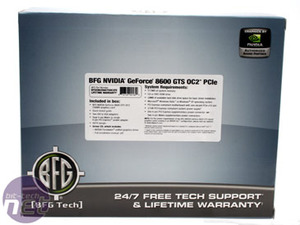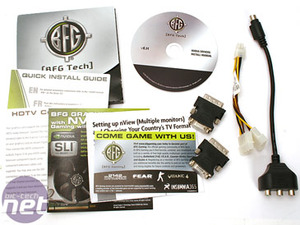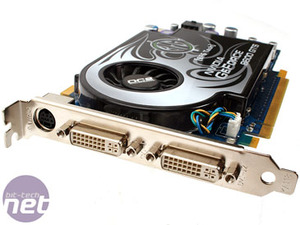BFGTech GeForce 8600 GTS OC2 ThermoIntelligence
Manufacturer: BFGTechCore Clock: 720MHz
Shader Clock: 1566MHz
Memory Clock: 2220MHz
Warranty: Ten years in Europe, Lifetime in the US
UK Price (as reviewed): £146.86 (inc VAT)
US Price (as reviewed): $244.99 (ex. Tax)
Nvidia’s graphics card launches are typically greeted with a slew of announcements from the company’s increasing number of board partners. In particular, there is usually fierce competition between the usual suspects, who often introduce products with clock speeds well above what Nvidia specifies, as each is trying to outdo its competitors in a sometimes frivolous manner.
One partner that doesn’t tend to get involved in the kafuffle is BFGTech, which usually introduces products with modest factory clock speed increases on Nvidia’s launch day. Recently though, things changed a little and the company introduced the “OC2” line – essentially an enhancement on its “OC” family that shows up some time after the official launch day.
This, the company claims, is because it conducts extensive testing to ensure that these overclocks are safe not only in the short term, but also in the long term too. Don’t forget that BFGTech offers a lifetime warranty on all of its video cards in North America and ten years in Europe – the last thing the company wants to have to deal with is a large number of returns a few years into the warranty because of a reckless overclock. Taking this at face value, it does appear to make sense to us – at least from a business perspective because returns cost any vendor money and that eats into the bottom line.
In addition to the OC2 family, which was first introduced with the GeForce 8800 group of products, BFGTech has also introduced a new initiative or product strand, known as the ThermoIntelligence series. BFG says that this is a select series of BFGTech graphics cards equipped with high-performance custom cooling solutions designed to dissipate heat more efficiently.
Today we have a look at the first card in the ThermoIntelligence series: the BFGTech GeForce 8600 GTS OC2. Let’s find out how it gets on...
The box is particularly bland, but that's because the card we've got here was sent to us almost as soon as the product was announced. From what we have been told, the retail box is similar to the other BFGTech boxes with the window - there's an example of what the box looks like on the company's website.
What you inside the box is exactly the same as you'll get in the retail bundle and is pretty much what we've come to expect in a BFGTech graphics card box these days. You'll get a pair of DVI-to-VGA converters, a six-pin PCI-Express power adapter, a component out dongle, a driver CD (that also includes a soft copy of the full manual), some BFG marketing material and a quick install guide.
BFGTech's GeForce 8600 GTS OC2 card still follows the basic Nvidia reference design, but there are some slight differences. Some are obvious, some are not - we'll cover the less obvious differences first. Being that this is part of BFGTech's OC2 line, the company has increased the card's clock speeds fairly significantly.
The core speed has been increased from 675MHz to 720MHz - just 10MHz higher than the core speed on BFGTech's GeForce 8600 GTS OC. As a result of this speed up, the shader clock has also been increased from 1450MHz to 1566MHz. Last, but by no means least, the memory clock has also been given a speed bump from 2000MHz to 2220MHz - 200MHz higher than the memory clock on the company's 8600 GTS OC.
Both of the card's DVI connectors are dual-link capable and also support HDCP at resolutions up to 2560x1600 - the latter is something that cannot be said for Nvidia's GeForce 8800 family. There's also a 7-pin analogue video out port that supports S-Video directly and you can also connect the included component dongle if, for example, you want to connect an HDTV via component.
Moving on to the more obvious differences, BFGTech has moved away from Nvidia's mean green PCB dye and has instead opted for a royal blue shade - that's mainly for aesthetic purposes though. The most important difference and the one that makes this card a part of BFGTech's ThermoIntelligence line is the refined heatsink design - this, according to BFG, is what allows this card to run safely at its enhanced speeds, while still being a single slot solution.

MSI MPG Velox 100R Chassis Review
October 14 2021 | 15:04














Want to comment? Please log in.